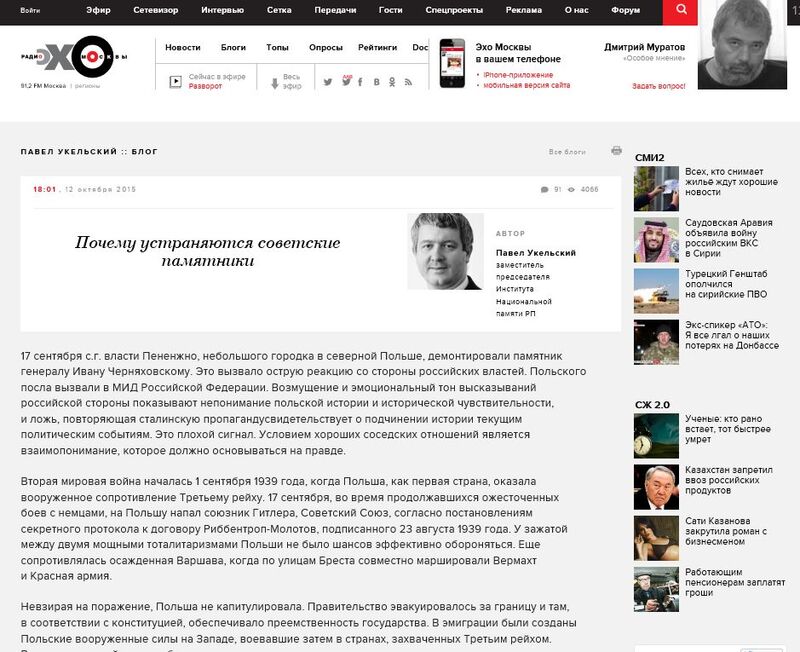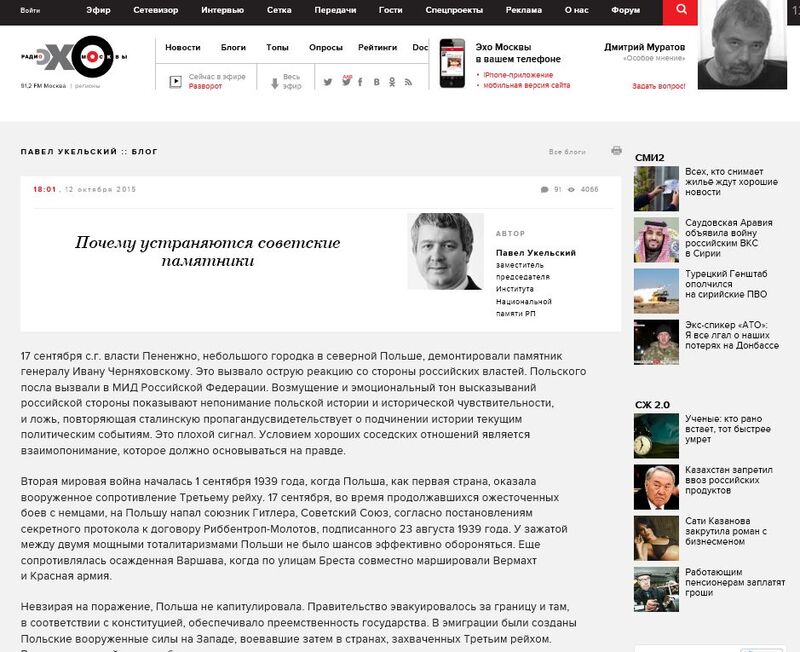On 17 September this year the authorities of Pieniężno, a small town in northern Poland, dismantled the monument of General Ivan Chernyakhovsky. This provoked a sharp reaction from Russian authorities. Poland's ambassador was summoned to the Foreign Ministry of the Russian Federation. The indignation and emotional tone on the Russian side indicate a lack of understanding of the Polish history and historical sensitivity, and the lies that replicate the Stalinist propaganda testify to the subordination of history to current political developments. This is a bad signal. The condition of good neighborly relations is mutual understanding, which must be based on the truth.
World War II broke out on 1 September 1939, when Poland – as the first country - militarily opposed the Third Reich. On 17 September, when the Polish Army was offering stubborn resistance to the Germans, Poland was invaded by Hitler's ally the Soviet Union, in accordance with the secret annex to the Molotov-Ribbentrop Pact, signed on 23 August 1939. Surrounded by two powerful totalitarian regimes Poland had no chance of an effective defense. The besieged Warsaw was still defending itself, when on the streets of Brest a joint parade of the Wehrmacht and the Red Army took place.
Despite the defeat, Poland did not capitulate. The government evacuated abroad, where, in accordance with the Polish Constitution, it preserved the national continuity. In exile the Polish Armed Forces in the West were formed, which later fought in countries assaulted by the Third Reich. In the occupied country state institutions in the conspiracy were created - civil administration, schools, courts, the media and the military forces. The whole of this structure was a phenomenon in the world and was dubbed the Polish Underground State.
Life in the occupied country was extremely difficult. Both occupants used the policy of extermination of elites, fought the Underground, used terror. The symbols of the Soviet rule on the Polish territory are the deportation of more than 300,000 Polish citizens, mostly to Siberia and Kazakhstan, and the long-hidden murder of over 22 thousand representatives of the Polish elite, popularly known as the Katyń crime. For Poles it was clear that the Soviet Union is a hostile country, even though it was not officially in the state of war with Poland.
In the calendar of anniversaries 22 of June 1941 is an important date for the Russians – on that day the Great Patriotic War began. For Poles this date does not matter that much – on that day, like the day before and a day later, they died in Soviet prisons. One may even speak of a deterioration of the situation - many prisoners, which the Soviets could not evacuate, were slaughtered.
The war between the two occupants accounted for Polish hope and a chance to change the situation. Towards the progress of German troops Stalin made contact with the Polish government-in-exile and agreed to create a Polish army on the Soviet territory. Some prisoners left the camps, while the deported tried to reach the muster points. Many of them did not succeed.
The year 1943 marked a victory for the Russians at Stalingrad and the Arch towards Kursk. For Poles this year meant the loss of many hopes - General Władysław Sikorski died in a plane crash near Gibraltar, Chief Commander of the Army General Stefan Rowecki „Grot” was arrested by the Germans. But above all it was a year of discovering the truth about the Katyń massacre and breaking by Stalin relations with the Polish government.
Along with the progress of the Soviet offensive, the Polish authorities started to develop a plan of the operation „Storm” - local uprisings in the rear of German troops. The aim was to liberate the country from the Nazi occupation and to take over on the liberated territory. In 1944 this plan was put into effect - in some cases bringing military successes, when the Polish Home Army, acting jointly with the Red Army, took part in the capture of Vilnius and Lviv. Immediately after the cessation of fighting with the Germans representatives of the USSR, including the NKVD and Red Army officers, carried out mass arrests among the Home Army soldiers. Gen. Ivan Chernyakhovsky, whose statue has been dismantled recently in Pieniężno, led to the treacherous arrest of the commander of Polish troops in Vilnius, Colonel Alexander Krzyżanowski „Wolf” and the liquidation of the Polish Home Army units in Vilnus. Krzyżanowski was held in numerous Soviet prisons and camps, including Moscow's Butyrki, then he was sent to Poland, now ruled by the Communist authorities. Here he was arrested. He died in prison.
On 1 August 1944 the last act of the operation „Storm” began - in Warsaw an uprising against the Germans broke out. Opposite, on the other side of the river the Red Army stationed. Despite requests and pressure from the Polish Prime Minister and the Western allies, Stalin refused to help the fighting in Warsaw. After two months of fighting the Uprising collapsed - its balance includes more than 150,000 victims and completely destroyed Polish capital.
Another year brought the complete subordination of Poland to Stalin. Even extremely unfavorable for Poland settlements of the Yalta Conference were soon violated by the Soviet Union. On 27 March the leaders of the Polish Underground State, fully legal structures subordinated to the Polish government-in-exile, were invited to talks in Pruszków. The call turned out to be a trap - they were abducted and brought to justice in Moscow. Three of them, including Deputy Prime Minister Stanisław Jankowski and the last Chief Commander of the Army, Leopold Okulicki „Bear” died in Soviet prisons. Chairman of the parliament acting in German-occupied Poland, Kazimierz Pużak survived the Soviet prison, but after being arrested by the Polish Communist authorities lose his life in prison on the Polish territory.
The capitulation of Germany did not bring freedom to Poland. Brought on Soviet bayonets, slavery was brutally introduced by the Polish Communists under the dictation of Stalin. Those who chose to resist, died in battles with the Security Police and raids organized by officers of the Security Office and the NKVD. The symbol of these crimes was organized by the „Smersh” Augustowska Roundoup, with at least 600 people killed, their final burial place still not known.
In a country dominated by enforced regime show trials were held. Captain Witold Pilecki, the author of a report on German crimes at Auschwitz and participant of the Warsaw Uprising, was inhumanly tortured. Sentenced to death in a show trial, he was shot in the back of the neck. To this day the place of his burial has not been located. A similar fate was met by thousands of Polish patriots.
The repression encompassed not only activists of the underground. On the Upper Silesia and Pomerania tens of thousands of people were deported to forced labuor in the Soviet Union. On the German territories now belonging to Poland the Red Army was dismantling whole factories. Many valuable cultural monuments and archives exported in 1945 have not returned to Poland up to this day.
In postwar Poland, almost 500 monuments of „gratitude” to the Red Army were erected. These were only symbolic monuments standing in public, not hiding beneath them the remains of fallen soldiers. They popped up like mushrooms, but they were not erected by the society - they were the work of the Soviet Army. Under the false guise of gratitude they hid the true symbolism – the Polish enslavement and dependence on the totalitarian Soviet Union. It is not surprising that the free Poland wants to get rid of this ballast.
At the same time the Polish state meticulously takes care of the cemeteries of fallen Red Army soldiers, many of whom were killed on the Polish territory in the fight against the German army. Poles also lean over the fate of hundreds of thousands of Soviet prisoners of war, exterminated by the Nazis on Polish territory - in recent days the Centre for Polish-Russian Dialogue and Understanding published a book Jeńcy sowieccy na ziemiach polskich w czasie II wojny światowej [Soviet Prisoners on Polish Soil during World War II], edited by Jakub Wojtkowiak.
Dismantling the Red Army monuments it is not directed against Russia and Russians. Poles are well aware that millions of Russians were victims of the same inhuman totalitarianism. We are convinced that all victims deserve to be remembered and respected. It is this respect that requires the removal of monuments constituting the residue of propaganda and falsifying history.
Russian version of the text :http://echo.msk.ru/blog/pavel_ukelsky/1639046-echo/


